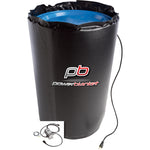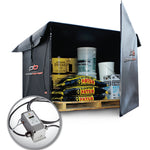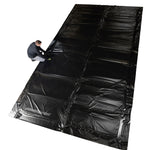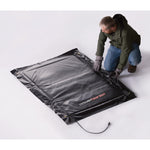You have no items in your shopping cart.
Article At-a-Glance
Can You Successfully Complete Roofing Projects in Cold Weather?
Yes, roofing projects can be successfully completed in cold weather by using specialized techniques and equipment, such as maintaining material temperatures with heaters and ensuring proper sealing and bonding of shingles, even when temperatures drop below the ideal range of 40°F (4°C) to 85°F (29°C).
Key Takeaways
- Understand Temperature Limits: Roofing in cold weather is feasible, but it's crucial to know that temperatures below 40°F (4°C) can affect the adhesion and flexibility of materials like asphalt shingles, potentially leading to installation issues.
- Prepare Materials Properly: Use heaters and warmers to maintain the pliability of shingles and the effectiveness of adhesives and sealants. This ensures materials remain workable and can bond correctly despite the cold.
- Implement Safe Practices: Ensure the roof deck is dry and free of ice before installation. Use controlled heat sources cautiously to remove frost and encourage proper sealing of shingles.
- Use Specialized Equipment: Opt for cold-weather fasteners and bulk material warmers to prevent brittleness and ensure materials remain in optimal condition throughout the project.
- Prioritize Safety and Inspection: Protect newly installed shingles from the elements and conduct thorough inspections to confirm proper sealing and bonding, ensuring a durable and successful roofing project.
The Professional Guide to Roofing in the Winter
The onset of winter doesn’t mean waiting until spring to complete roofing projects. This guide helps homeowners and contractors know how to conquer winter roofing challenges with heat control techniques and best practices for a successful and durable cold-weather roof installation.
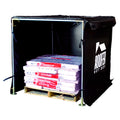
$3,303.99 USD
64 CU/FT Roofer Bulk Material Warmer (12 Amp, 120V)
For large-scale winter roofing projects, Heat Authority's Bulk Material Heaters provide efficient heating solutions to keep materials ready for use, ensuring smooth installations even in cold weather.
Can You Roof a House in Cold Weather?
Yes! While spring and summer might seem like the natural seasons for roof replacement, winter doesn't necessarily have to be a time to put those plans on hold. There are definitely challenges to working with roofs in cold weather, but with careful planning and the right materials, winter roof installation can be a success.
What Temperature is Too Cold for Roofing?
It goes without saying that some temperatures are too cold to work in. There are key differences to roofing in winter weather versus spring and summer temperatures. By learning what needs to be done differently, you can keep projects moving forward without waiting for warmer weather.

What Temperature is Needed for Shingles to Seal?
The ideal temperature range for working with shingles falls between 40°F (4°C) and 85°F (29°C). Going below this range presents the risk of the adhesives used to secure shingles and flashing not activating or curing properly, leading to leaks and potential roof failure down the line.
How to Extend the Roofing Season
When dealing with the risks of cold weather roofing, consider what techniques and equipment might protect your project from low temperatures. Plan ahead by preparing materials to remain operational when exposed to cold air.
Preparing the Roof Deck in Cold Weather
Before laying a single shingle, it's crucial to ensure the roof deck itself is properly prepared for winter work. The deck must be completely dry and free of any ice or frost. Any moisture, even when frozen, can hinder proper sealing and lead to future problems. If necessary, use shovels and brooms to remove ice and snow from the deck.
In extreme cases, carefully controlled heat sources like propane torches (used by qualified professionals) or thawing blankets can be used to melt frost or ice, but caution is crucial to avoid damaging the underlying structure. Extra-hot thawing products, such as this one below, can be helpful for melting thick layers of ice off of roof decking before installation.

Impact of Cold on Adhesives and Sealants
Cold temperatures also impact the effectiveness of adhesives and sealants used in roofing applications. Many products have minimum application temperatures listed on their labels. Using these products below the recommended temperature can compromise their ability to bond properly, potentially leading to leaks.
Working with Cold Shingles and Materials
Shingles can become stiff and inflexible in low temperatures, making them more difficult to cut and install without cracking. To overcome this challenge, several solutions exist to help keep materials warm until they’re ready to be used on the roof.
Shingles and Sealants
Investing in shingle warmers, portable containers that use heat to keep shingles pliable, is a viable option. This ensures a smoother cutting and installation process. Similarly, keeping buckets of adhesives and sealants warm with dedicated heaters is crucial (check out our bucket and pail heaters). Proper flow and application during installation depend on it.
In situations where materials are kept on the roof during installation, low temperatures and inclement weather can freeze or thicken sealants even if you’ve pre-warmed them. Caulk warming pouches are perfect for maintaining temperatures to keep caulk pliable up to the moment you need it. Heaters such as these examples are key for successful winter roof installation.

Caulk warming pouches keep sealants thawed and ready to use.
Cold-Weather Fasteners
Standard nails and staples just won't do in cold weather. Select cold-weather fasteners designed specifically for these conditions to minimize brittleness and the risk of damaging shingles.
Bulk Materials
For larger projects requiring significant quantities of materials, consider using bulk material warmers. Bulk material warmers envelop entire pallets with heat, ensuring the materials remain pliable and workable throughout the project.
Allowing Proper Sealing and Bonding
One of the biggest concerns with cold-weather roofing is the ability of new shingles to properly seal and bond to the underlying deck. Cold temperatures can slow down the sealing process of asphalt shingles. Here are some steps roofers can take:
- Apply Shingle Starter Strips: Using self-adhering starter strips at the eaves helps create a strong initial seal and improves the overall sealing performance of the shingles.
- Heat Sources for Encouraging Sealing: In some cases, roofers might use controlled heat sources like roofing torches to gently warm the shingle edges, encouraging a tighter seal. This technique should be used with extreme caution and only by experienced professionals.
- Testing Shingle Bond: Once the shingles are applied, it's crucial to test the bond strength, especially in colder conditions. This can be done by carefully lifting a corner of a shingle and checking for proper adhesion.
Protecting Shingles After Installation
Newly installed shingles are particularly vulnerable to the elements until they have a chance to fully cure and seal. Here's how to protect them after laying them down:
- Shielding from rain or snow: If rain or snow is forecasted after installation, take steps to shield the exposed roof with tarps or other waterproof coverings.
- Supplemental heat for sealing: In some cases, temporary heat sources like warming blankets or portable propane heaters can be used strategically to promote faster drying and sealing of the shingles. However, proper ventilation is important to avoid moisture buildup and ensure the safety of workers.
Signs Shingles Have Properly Set
Just as in normal conditions, you’ll need to inspect your roof to make sure everything was installed correctly and that cold air didn’t warp or offset any shingles. When visually inspecting the shingles, look for a smooth, uniform appearance across the shingle surface. Curling or lifting edges might indicate improper sealing. Also make sure to perform a tactile test: carefully run your gloved hand across the shingle surface, as properly sealed shingles should feel secure and not easily lift or move.
Winter Roofing - It Can Be Done!
While roofing in winter requires more planning, preparation, and specialized materials compared to warmer months, it’s definitely achievable. By following the best practices outlined above, homeowners and roofing contractors can ensure a successful and long-lasting roof installation even in the face of winter's chill.







